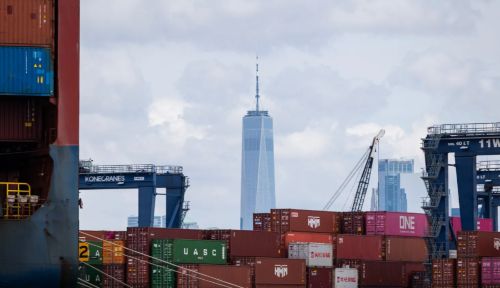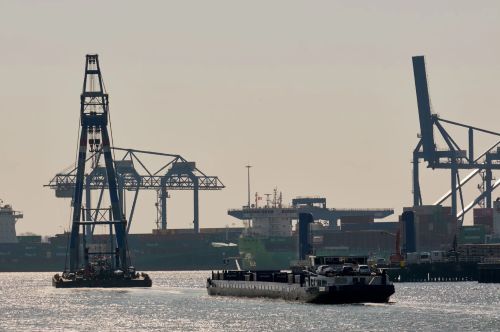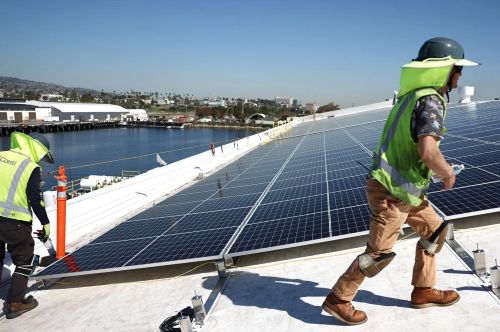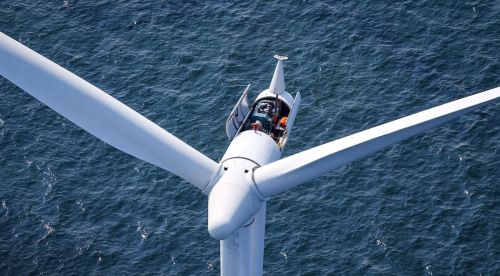

Pressing issues shaping the future of the transatlantic alliance.
Introduction

By Allison McManus
Managing Director, National Security and International Policy
The Center for American Progress

By Dr. Robert Benson
Associate Director
National Security and International Policy
The Center for American Progress
Since beginning his second term in office, U.S. President Donald Trump and his administration have taken swift actions to undermine the foundations of alliance and partnership between the United States and Europe. These efforts come at a critical moment in which the United States and Europe face significant transatlantic challenges that demand shared solutions—from security and migration to trade, climate, and digital governance.
Against this backdrop, frank dialogue is more crucial than ever. This joint report by the Center for American Progress and the Foundation for European Progressive Studies (FEPS) aims to demonstrate that the long-standing relationship between the United States and its European partners is stronger than one administration. It brings together 10 leading voices from the United States and Europe to offer perspectives on five of the most pressing issues shaping the future of the transatlantic alliance:
- Security: U.S. Rep. Jason Crow (D-CO) draws on his military service to outline the enduring value of transatlantic cooperation in addressing traditional defense challenges, hybrid threats, and emerging domains such as cyberspace. Former Swedish Minister for Foreign Affairs Ann Linde offers a European perspective on strategic autonomy and alliance building—and reflects on Sweden’s historic accession to NATO as a turning point for European security.
- Migration: Dan Restrepo, senior fellow at CAP and former senior director for Western Hemisphere affairs at the National Security Council, offers a strategic vision for managing migration rooted in the national interest, economic pragmatism, and democratic values. Hedwig Giusto, senior research fellow at FEPS, explores the path toward a more coherent and values-based European migration framework—and warns that a narrow, security-driven approach will only strengthen the political winds powering the far right.
- Trade: Elizabeth Baltzan, former councilor for trade and investment at the Office of the U.S. Trade Representative in the Biden administration, reflects on the limits of globalization and calls for new trade rules that strengthen democratic economies. Former Czech Minister of Foreign Affairs Tomáš Petříček offers a European approach focused on strategic industries, resilience, and social fairness.
- Climate: Frances Colón, senior fellow for International Climate Policy at CAP and former deputy science and technology adviser to the U.S. secretary of state during the Obama administration, outlines a U.S. climate strategy grounded in environmental justice and innovation. Florian Ranft, executive board member at Das Progressive Zentrum, charts the EU’s path toward a green industrial transformation rooted in solidarity and long-term sustainability.
- Digital governance: Alondra Nelson, distinguished senior fellow at CAP and former deputy assistant to the president and acting director of the White House Office of Science and Technology Policy in the Biden administration, highlights the need for digital governance that balances guardrails and responsible innovation. Member of the European Parliament Alex Saliba underscores the urgency of regulating this new frontier—and calls on the EU not to back down from that task.
Together, these essays underscore the continued relevance and necessity of U.S.–EU cooperation. They show that while the moment is turbulent, forging transatlantic commitment to overcoming challenges is possible—and urgent.
The National Security and International Policy team at CAP would like to thank Mike Williams and Ryan Mulholland for their exceptional expertise and stewardship of this project. We are also grateful to our colleagues and partners at the Foundation for European Progressive Studies, including Anna Kolesnichenko, David Rinaldi, Vanessa Zwisele, Beatriz Abellán Merelo, and Thainá Leite, for their invaluable insights and project management. A special thank you also goes to Florian Ranft from Das Progressive Zentrum and Knut Panknin from the Friedrich-Ebert-Stiftung for their thoughtful collaboration.
At CAP, we want to especially recognize our tremendous research assistants, Sadhana Mandala and Laura Kilbury, for their diligence, and the entire International Climate team—Courtney Federico, Kalina Gibson, and Frances Colón—for their support and contributions.
Many thanks as well to Mona Alsaidi and Audrey Juarez from CAP’s Legal team, and to the stellar Production and Editorial team for their keen eye and tremendous turnaround.
Of course, this report would not have been possible without the meaningful contribution of all of our authors. For this, we are most thankful.
The American Case for the Transatlantic Alliance


By Rep. Jason Crow
U.S. Representative (D-CO-06)
Overview
U.S. leaders must work to reaffirm the value of international agreements and partnerships.
The transatlantic alliance has been a cornerstone of collective security, democracy, and economic resilience for more than 70 years. The United States and its allies in Europe have stood together to confront tyranny, bolster democracy, and expand freedom. This partnership is a commitment to the idea that when democracies stand united, they can be the most powerful force for security, stability, human rights, and economic progress in the world.
Today, that commitment faces an unprecedented test—not just from Russia’s unprovoked invasion of Ukraine, the largest land war in Europe since World War II—but also from the Trump administration’s reckless behavior. If the rifts that President Donald Trump has created deepen, they will weaken the most successful alliance in modern history, leaving both America and Europe less secure and less prosperous. This chapter considers the state of the transatlantic alliance—and how it can move forward.
Strategic Context
While the security and economic benefits of the transatlantic alliance are numerous, its strength has never been in shared interests alone. Instead, its strength has been rooted in shared values and a common vision for global security: that all nations regardless of size or resources should abide by a common set of rules and respect the sovereignty of others. The world has seen this shared vision in action many times. NATO and the broader U.S.-European alliance were central in defeating the Soviet Union, stopping genocide in the Balkans, and deterring Russian aggression in Ukraine. In the aftermath of September 11, European allies invoked NATO’s Article 5 for the first and only time, declaring an attack on the United States an attack on all. I served three combat tours overseas, including in Afghanistan, where I saw firsthandthat the NATO alliance is not charity. Men and women from NATO member nations fought and died alongside American troops in that theater, proving this alliance is not one-sided—it is a shared investment in collective security. That investment remains critical as the United States and Europe confront Russian aggression, Chinese military competition, rising far-right extremism, and the increasing militarization of space and cyberspace.
Yet President Trump is working relentlessly to weaken NATO. He has questioned its relevance, misrepresented alliance defense spending, and treated America’s security commitments as mere bargaining chips. It seems he views partnership only as a series of business transactions on a ledger. It is a small, one-dimensional way of thinking and the type of approach that adversaries have already discovered does not work well. Trump’s rhetoric and actions have sown distrust among America’s allies in Europe, diminishing NATO’s deterrent power. Worse, Trump’s vision for America is not just one of global retreat but of aggressive hypernationalism. He has openly talked about purchasing Greenland—a Danish territory and NATO ally—and even suggested annexing Canada into the United States.
A Weakened Transatlantic Alliance Will Isolate the United States
The consequences of a weakened transatlantic alliance are profound. A fractured NATO would give Russia the opportunity to expand its influence beyond Ukraine, directly threatening the Baltics, Poland, and beyond. It would also force Europe to pull away from the many joint intelligence, law enforcement, and military operations that benefit Americans and make the nation safer. While the European Union and individual member states are investing to strengthen their defense capabilities, these initiatives will take more time, and without U.S. leadership, pulling back from U.S. commitments puts everyone at greater risk.
Support for Ukraine is the most visible test of Western unity, but it is not the only one. The broader challenge is whether the United States and Europe will remain strategically aligned in the decades ahead. Energy security, climate change, artificial intelligence, and technological dominance are all arenas where cooperation—or lack thereof—will shape global power structures. The hard truth is that if the United States retreats from leadership in these areas, Europe will have no choice but to look elsewhere. The United States will find itself isolated, weaker, and unable to help craft the new rules and standards for emerging technologies and markets.
For President Trump, cooperation seems to be a weakness and alliances seem to be a burden—but this is a dangerous belief, one that ultimately comes at the expense of American security and economic prosperity. His approach needlessly isolates the United States and leaves it less secure. Americans care about being safe from terrorist attacks and staying out of needless wars. Preserving the safety of Americans means working with allies to share valuable intelligence and to prioritize diplomacy—and deterrence, when necessary—to avoid armed conflict.
A divided West would hand China and other U.S. adversaries greater leverage in shaping global norms—particularly in trade, technology, and human rights—at the direct expense of democratic values. Beijing in particular would move swiftly to cement its influence, setting the rules of the global economy and expanding its authoritarian reach. Meanwhile, U.S. partners, left uncertain and exposed, would have no choice but to deepen economic and political ties with China. This would be a self-inflicted strategic disaster at the very moment when American leadership is most critical.
Advancing Shared U.S.-Europe Agendas
Restoring America’s credibility will require decisive action. American leaders, especially members of Congress, can act now, with or without the Trump administration. They need to reaffirm the value of international agreements that the Trump administration recklessly abandoned, from arms control treaties to climate commitments that affect global security. Congressional, business, and civil society leaders can also use their informal role in foreign policy to engage with foreign leaders, attend conferences, travel abroad, and show their commitment and interest in others despite the retrenchment of this administration. They must prove that America is a reliable partner by showing that America is much more than any one presidential administration and by working closely with allies to confront global challenges, from securing clean energy technologies to countering China’s economic influence and military expansionism.
American and European leaders also need to present a united front in countering the hybrid threats posed by authoritarian adversaries. Disinformation campaigns, cyber warfare, and election interference have targeted democratic institutions on both sides of the Atlantic. Strengthening intelligence sharing, cybersecurity cooperation, and joint initiatives to combat foreign influence operations will be critical to safeguarding democratic systems. Economic tools must be part of this strategy: The West should move toward coordinated sanctions and trade policies that prevent adversaries from exploiting loopholes between U.S. and European market. That includes pushing this administration to stop the chaotic tariff policy that is hitting America’s allies hard and throwing global markets into disarray.
To prevent a permanent rupture, a future U.S. administration should, as a matter of priority, reinforce its commitment to Europe beyond the crisis in Ukraine. That means reaffirming NATO’s Article 5, expanding joint military exercises, and investing in next-generation deterrence capabilities. It also means engaging in deeper economic coordination on trade, supply chains, and industrial policy so that partners are not left competing against one another while China consolidates global influence.
The Trump administration’s foreign policy weakens America, emboldens adversaries, and undermines democratic values. But this alliance is bigger than one administration. The United States and Europe must remain united—not only to counter today’s threats but to build a more secure and prosperous future. Ruptures in the transatlantic alliance cannot become a generational wound from which the West may never fully recover. Both sides of the Atlantic must choose strength over retreat, unity over division, and real leadership over chaos and weakness.
EU-U.S. Relations in the Peace and Security Domain


By Ann Linde
Former Minister for Foreign Affairs (Sweden)
Special Advisor on Foreign Affairs and Co-Chair of the Feminist Foreign Policy Progressive Voices Collective
Foundation for European Progressive Studies (FEPS)
Overview
Progressives in the European Union and the United States must strengthen ties in the face of growing U.S. isolationism.
The transatlantic relationship faces a defining moment. As the United States contends with rising isolationism and growing skepticism toward global alliances, Europe must prepare for a more uncertain partner across the Atlantic. This chapter draws on the author’s experience as Sweden’s foreign minister and the country’s historic accession to NATO to reflect on how Russia’s war against Ukraine has fundamentally reshaped Europe’s security landscape—and how progressives on both sides of the Atlantic must respond. The chapter explores diverging trends in U.S. and EU foreign policy, the need for European strategic autonomy, and the critical importance of sustaining civil society cooperation.
Strategic Context
On May 18, 2022, Sweden’s application for NATO membership was officially handed in to the NATO secretary general. Russia’s full-scale invasion of Ukraine in February of that same year led to this decision—a decision that ended 200 years of successful military nonalignment that kept Sweden and the Swedish people out of war. Russia’s brutal violation of international law—invading a peaceful country through violence, terror, and the murder and rape of civilians—profoundly affected people in Sweden and Finland. Both countries concluded that they needed NATO’s Article 5—in practice, the certainty that the United States would come to their aid if Russia subjected them to military conquest—in order to ensure the security of their populations. That protection arrived in earnest on March 7, 2024, when Sweden officially joined as the 32nd member of the NATO alliance.
Policy Continuity and Change
Since the second Trump administration came to power in the United States, a sense of insecurity has spread across Sweden and much of Europe. On several occasions, President Trump has expressed that he is not prepared in all situations to use military force to fulfil U.S. obligations under Article 5. These pronouncements have raised concerns in Sweden and across Europe. According to a survey published at the end of March 2025 of more than 10,000 Europeans in nine countries, 55 percent now believe that there is a high risk of an armed conflict breaking out in the EU’s territory in the coming years. Furthermore, 63 percent believe that the election of Donald Trump makes the world less secure, and a majority—51 percent—believe that he is an enemy of Europe.
In March 2025, a delegation from the Foundation for European Progressive Studies (FEPS) visited New York in connection with the U.N. Commission on the Status of Women. A series of talks were held with academics, diplomats, and politicians from the United States. The author’s predominant feeling following these conversations was fear. People fear expressing their true opinions about the unfolding political situation in the United States. Time and time again, the U.S. interlocutors said, “This is how I see it, but absolutely do not attribute these views to me.” Unfortunately, after the administration’s draconian firing of federal employees, the dismemberment of congressionally chartered federal agencies, and the suspension of funding for academic institutions, this fear is well founded. And this, of course, makes dialogue between progressives in Europe and the United States much more difficult. The question, therefore, is how progressives in Europe are going to deal with this new situation.
On the fundamental issue of peace and security, progressives on both sides of the Atlantic must continue to provide Ukraine with military, political, and humanitarian support. A situation in which Ukraine loses significant parts of its territory and is not allowed to choose its own security path forward would have devasting consequences.
Diverging Interests and Approaches between the United States and the European Union
Trump’s seismic decisions have accelerated the realization that European countries need to improve their defense capabilities—both individually as member states and together at the pan-European level. In Sweden, the Social Democratic Party has proposed a Total Defense Fund—both military and civilian—that would lend up to 25 billion euros to build up and enhance military and civilian defense. In Germany, the Christian Democrats, the Social Democrats, and the Greens have, in the most recent lame duck session, taken an affirmative step to deficit spend in support of critical defense and welfare needs.
For the current EU leadership, boosting EU defense initiatives by expanding and deepening projects such as Permanent Structured Cooperation and the European Defense Fund is seen as inevitable to reduce reliance on the U.S. European militaries need to further modernize their intelligence, cyber defense, and missile defense systems, as well as improve logistics and rapid troop deployments across Europe to improve deterrence capabilities. NATO’s European pillar must also be enhanced. A push for a more self-sufficient European contribution within the NATO alliance—one that avoids overdependence on American leadership—is sorely needed.
Although a strong transatlantic link remains critical, the time has come to strengthen Europe’s strategic autonomy. Europe needs to reduce reliance on U.S. technology by investing in European arms industries and critical technologies. To hedge against U.S. unpredictability, Europe should also diversify its security partnerships and build stronger ties with Canada, Japan, and Australia.
Advancing Shared Agendas
If the transatlantic link on the national level is weakened, it is more important than ever that progressives invest in deeper civil society cooperation. FEPS and the Center for American Progress have successfully cooperated for many years now. In these difficult times, cooperation should be made even stronger, with more common projects such as developing targeted messaging for different audiences across urgent policy spaces—chief among them, the mutual benefit derived from a strong transatlantic partnership. The following recommendations aim to guide future U.S. policymakers and progressive civil society leaders on both sides of the Atlantic in strengthening and defending the transatlantic relationship.
Future U.S. policymakers should:
- Emphasize Europe’s role in hosting U.S. military bases that support global American operations.
- Show how European defense investments and NATO commitments reduce the burden on U.S. taxpayers.
- Highlight the economic and geopolitical risks of a weakened NATO, including the potential for greater Russian and Chinese influence.
Civil society actors such as think tanks, the media, and public opinion researchers should:
- Stress that European security directly protects U.S. interests, including supply chains, global trade, and counterterrorism efforts.
- Highlight that NATO allies supported the United States in Afghanistan and other global missions.
- Make the case that European allies help stabilize global conflicts, reducing the need for U.S. intervention.
- Highlight European contributions to NATO—such as Baltic defense, joint exercises, and counterterrorism—to counter the “Europe doesn’t pay its fair share” narrative.
- Engage with diaspora communities—such as Irish, German, Italian, Nordic, and Polish Americans—to rally support for strong U.S.-Europe relations.
It is clear that Europeans understand that the current situation is both dangerous and volatile, and that there is a need for enhancing European defense. But Progressives cannot accept this without balancing additional defense spending with maintaining welfare, education, and development aid—as with, for example, the recent decision by the United Kingdom to fund increased defense spending by reducing development aid. Progressives in both Sweden and Germany have decided to support loans to secure higher defense spending with the precondition that they also invest in urgent welfare needs. Other revenue avenues should also be explored, including targeted tax increases, perhaps for a limited period of time, as recently proposed by the Sweden Social Democrats’ so-called “contingency tax.”
Finally, there is an urgent need for more multilateralism, not less. European progressives should strengthen alliances with like-minded democracies to counter U.S. isolationism. Europe should also raise up its own progressive organizations, such as FEPS, and work with willing partners such as CAP on a host of transnational issue areas. Times are tough, but progressives have never shied away from facing difficult realities. Now is the time to present a clear political vision with progressive values, diplomacy, and dialogue at its core.
Borders, Burdens, and Balance: A Strategic Vision for Migration in the United States and the European Union


By Dan Restrepo, J.D.
Senior Fellow
The Center for American Progress
Overview
A progressive governing vision on migration must acknowledge that the denial of the basic dignity of migrants is not just a harbinger of the erosion of others’ rights but a fundamental betrayal of core values and democratic principles in the United States and the European Union.
The strategic context surrounding migration in the Americas is shifting, and the United States’ response—particularly under U.S. President Donald Trump—has reshaped the region’s migration landscape. This chapter contrasts these developments with European approaches, highlighting both differences in baseline challenges and shared consequences of policy failure. Ultimately, this chapter argues that while enforcement is necessary, it cannot substitute for a well-ordered migration system rooted in national interest, economic pragmatism, and international cooperation.
Strategic Context
In the period immediately following the COVID-19 pandemic, the Americas have been home to historic levels of human displacement. Latin America and the Caribbean, while comprising 8 percent of the world’s population, account for 15 to 20 percent of the world’s displaced population as of 2023. Although more than 80 percent of displaced individuals have been absorbed elsewhere in the Americas, the United States has experienced significant migration management challenges. From 2021 to 2025, the United States saw 10.58 million encounters of irregular migrants at its border with Mexico, and in 2024, the U.S. foreign-born population reached a historic high of 15.6 percent. Against this backdrop, the American people have adopted increasingly restrictionist attitudes toward immigration and have rewarded politicians who promise immigration crackdowns—particularly President Trump.
Policy Continuity and Change
President Trump has made immigration enforcement a centerpiece of his agenda, prioritizing efforts to reduce the country’s foreign-born population. He has promised to deport millions of unauthorized migrants during his second term. To that end, he has moved to consolidate and enhance limitations on asylum imposed by his predecessor while ending recently created alternative legal pathways for migrants fleeing the region’s most unstable and repressive countries. The Trump administration has also engaged in unprecedented enforcement actions, including the use of military aircraft for deportation flights and the use of detention facilities at the U.S. Guantanamo Bay Naval Station for migrants awaiting deportation; deputization of a wide range of federal law enforcement officials to engage in immigration enforcement; invocation of the Alien Enemies Act of 1798 to target members of a Venezuelan transnational criminal organization; defiance of a court order seeking to prevent the expulsion of migrants to an infamous “super prison” in El Salvador; and high-profile targeting of the immigration status of student protestors. In addition, the Trump administration has eliminated scaled humanitarian parole programs for Cubans, Haitians, Nicaraguans, and Venezuelans and has taken steps to roll back Temporary Protected Status for Venezuelans. President Trump has also repeatedly used a purported lack of migration cooperation from Mexico and Canada as a reason for threatening those countries with 25 percent tariffs and has induced Panama and Costa Rica to accept deportees who originated from a third country.
Although the Trump administration’s immigration control efforts have started with a focus on eliminating irregular migration, they are unlikely to end there. During his first term, Trump sought to reduce legal migration, and the governing guide for his second administration—Project 2025—calls for severe limits on legal migration to the United States.
Efforts to reduce the foreign-born population will have adverse effects on the U.S. economy, spurring inflation, reducing growth, and aging the population. These efforts will also fuel transnational organized crime as cartels are deeply enmeshed in human smuggling and trafficking, both in the Americas and beyond. Since the underlying reasons for human mobility are unlikely to abate as limited lawful migration pathways are eliminated, people will continue to try to migrate, even if they must do so in a dangerous manner.
Diverging Interests and Approaches between the United States and the European Union
U.S. and EU migration management depart from different baselines. The foreign-born population currently comprises 15.6 percent of the U.S. population and 9.9 percent of the EU population, albeit with notable variance among member states. Among the foreign-born population, irregular migration is less common than is frequently perceived. In the European Union, for example, less than 10 percent of migrants arrived via irregular channels in 2023. In the United States, the unauthorized population is still less than one-quarter of the foreign-born population, despite recent increases in the unauthorized population. The paths followed by irregular migrants to the United States and the European Union are also different, as are their respective response frameworks.
While increasing forced displacement is a global phenomenon, most human mobility occurs in regional or hemispheric migratory systems. As a result, migration to the EU today is primarily from Eastern Europe, the Middle East, and Africa, while migration to the United States originates primarily—but not exclusively—from the countries of the Americas; both the United States and the EU are seeing significant migration, irregular and otherwise, from India and China. While the European Union has mechanisms, albeit flawed ones, designed to share the burden of reception among member states, no such mechanism exists in the Americas, nor within the United States.
Nevertheless, the consequences of irregular migration to the United States and the EU are similar: It undermines confidence in government, provides significant fuel to nativist politicians, and creates an economically negative backlash against legal migration. The United States and the European Union thus have a shared interest in crafting and deploying policy solutions that promote well-ordered migration and meet their respective interests.
Advancing Shared Agendas
Any approach to managing migration must be firmly rooted, both in reality and in rhetoric, in the national interest, not only or even primarily in the interest of migrants. A well-ordered migration system with clear rules and accountability for all—from those responsible for the conditions leading to displacement, to those on the move, to those crafting and implementing policy—should be nonnegotiable. So too should be an unwavering commitment to target criminal organizations and their collaborators who undermine ordered migration and prey on the vulnerable.
A well-ordered migration system would have significant economic benefits. The recent influx of migrants to the United States, for example, is projected to generate a net benefit of more than $900 billion to the U.S. budget in the coming decade. A system that includes a regularization mechanism that provides legal pathways for undocumented people to regularize their immigration status would expand that positive effect at a time when the United States faces mounting fiscal challenges. Temporary regularization systems would help adjust a critical equation at times of significant influx, rapidly converting new arrivals from fiscal burdens to economic contributors, as they have in places such as Colombia. As a result, highlighting the positive economic effects of ordered migration is essential in laying out a progressive vision for migration management.
Coordinated enforcement efforts among countries of origin, transit, and destination are indispensable, as is all countries doing their share to present solutions to displacement as close to home as possible. In the Americas, this means supporting regularization and integration efforts that have succeeded in keeping more than 80 percent of displaced people in region during a tumultuous decade. Migrant stabilization efforts must be understood as the public international goods they are, and development finance—both multilateral and bilateral—must be leveraged to support such solutions at scale.
Enforcement without legal migration alternatives is a recipe for empowering organized crime, making vulnerable populations even more vulnerable, and sowing the chaos that undermines confidence in governments. Legal migration pathways must be reformed and crafted to meet key national needs. Collapsed U.S. and EU asylum systems must be reformed to restore functionality and conformity with moral and long-standing international obligations, even as those require modernization to meet today’s dynamics and not those of the 1940s and 1950s. Credible lines must be established and facilitated for those seeking family reunification; temporary work, commensurate with the labor needs of the countries of destination; or educational and professional opportunities.
A well-ordered migration system is also protective of migrants’ rights. Functioning asylum systems on both sides of the Atlantic, which do not exist today, would provide safe refuge for those in the gravest danger. Robust legal migration pathways would help unburden overwhelmed asylum systems and keep individuals away from the severe peril and uncertainty that defines irregular migration. Well-ordered migration systems also would deprive political actors who aim to restrict rights of vital oxygen—protecting rights for all, not just for migrants.
As the groundwork is laid for a progressive governing vision on migration, it is essential to confront today’s excesses. The denial of the basic dignity of migrants, regardless of legal status, is not just a harbinger of the erosion of rights for others but also a fundamental betrayal of core values and democratic principles. In the United States, immigration is an area of significant executive authority, but that authority is not a blank check for authoritarian disregard for the rule of law, including suspension of due process rights and rendition to third countries.
The State of Transatlantic Migration Policy


By Dr. Hedwig Giusto
Senior Research Fellow and Editor in Chief of the Progressive Post
Foundation for European Progressive Studies (FEPS)
Overview
The United States and the European Union must learn to address migration for what it is: an inherent and unavoidable element of the human, social, and cultural condition.
This chapter argues that progressives in Europe and the United States must reclaim the narrative on migration by rejecting the security-focused, fear-driven approaches that currently dominate policymaking. It urges policymakers to recognize migration as a constant, structural part of human development—not a crisis—and to build policies grounded in reality, rights, and economic need. Instead of competing with right-wing forces on punitive measures, progressives should advance humane, effective, and values-based alternatives focused on legal pathways, integration, and labor protections.
Strategic Context
In Europe, no progressive party or candidate can win an election on the topic of migration—not in a political landscape poisoned by a decade of toxic discourse about migration and migrants. This past February’s federal election in Germany offers the most recent, though hardly the only, example. The Social Democratic Party’s “traffic light” coalition—made up of the Greens and the liberal Free Democratic Party—suffered a defeat, while the increasingly restrictive Christian Democrats won. The far-right Alternative for Germany party came in second by popular vote share after campaigning aggressively against immigration. Once again, a progressive party failed to regain control of the narrative on migration.
While migration remains top of mind for EU general public—and European right and far-right parties opportunistically keep it in the headlines by deliberately spreading disinformation—there is little hope that public attitudes toward migration will improve.
Regrettably, the broader geopolitical landscape presents a grim outlook. Ongoing conflicts in Ukraine, the Sahel, and Gaza; fragile states such as Syria; and the shift in U.S. migration policy under the second Trump administration—all occurring alongside climate change and the growth of populations and inequality—will further drive displacement. This, in turn, will bolster the pervasive and often inaccurate narrative of migration as being beyond control, framing the situation as an unprecedented “crisis” solvable only through extreme measures. These measures often include strict border controls, deportation, repatriation, or detention, primarily aimed at reducing numbers and criminalizing migrants.
To free themselves from this spiraling, security-focused approach, the United States and the EU must learn to see and address migration for what it is: an inherent and unavoidable element of the human, social, and cultural condition. As such, it is neither bad nor good. A clear understanding of the nature of migration will help U.S. and EU leaders recognize that trying to curb it is both impossible and often counterproductive. This, in turn, can pave the way for migration policies grounded in reality rather than misleading concepts—policies that can manage migration effectively.
Policy Continuity and Change
The current reality of migration is still one of deep divisions, both within and between countries.
In the European Union, while migration management is still largely in the hands of the member states, the notion that it can only be tackled collectively—especially in a jurisdiction where individuals can move freely across national borders—has led to attempts to harmonize and define common norms and procedures. Such attempts, however, have clashed with various ideological positions and perceived diverging interests—for example, between border member states or countries of first entry on one hand and internal member states or countries of destination on the other.
Over the past decade—since the crisis triggered by the failure of the Arab Spring in the Middle East and North Africa, along with the decadeslong civil war in Syria—EU member states have increasingly diverged in their views on the principle of mutual solidarity. This divide has been especially visible in debates over which country should bear responsibility for processing asylum applications, blocking progress toward a common migration policy and reform of the asylum system.
In December 2023, after years of exhausting negotiations, the European legislative bodies—the Council of the European Union and the European Parliament—finally reached an agreement, and the new Pact on Migration and Asylum was finally adopted the following April. Just ahead of the June European elections and the start of a new EU political cycle, the long-awaited pact set out new rules to manage migration and reform the common asylum system. However, it is not yet clear whether this marked a true turning point. While the pact has faced deep criticism concerning its effectiveness, particularly that of its solidarity mechanism—which aims to distribute responsibility for asylum seekers among member states through relocations, financial contributions, or operational support—and of its capacity to safeguard human rights and vulnerable groups, the EU’s previous difficulties in finding a compromise on this contentious migration dossier make reopening debate on it highly undesirable.
EU member states have until June 2026 to implement the pact. However, despite the legislative framework being relatively new, several centrifugal forces seeking to pursue autonomous and stricter national migration policies have already emerged: Austria and Germany have resumed border control, Poland has suspended the right to asylum, and Italy has signed a memorandum with Albania that aims to externalize asylum processing from Italy to Albania for certain migrant categories intercepted at sea. This initiative, which is being challenged by Italian courts over its legality and human rights concerns, remains largely unapplied. At the time of publication, the Italian government has approved a new law to use the centers in Albania as repatriation hubs, and the initiative is being closely watched by the new European Commission and other EU member states that see it as a potential model.
To a certain extent, the commission’s March 2025 proposal for a return regulation aligns with the Italian-Albanian deal. Returns have long been a key priority for the European Union, as the limited success in enforcing the return of foreign nationals who do not meet legal residency requirements is widely seen as a major weakness of the EU migration system. The new proposal would enable EU member states to remove those who are not EU nationals staying irregularly to any third country, provided that there is a bilateral or EU-level agreement and human rights are respected. It would also mandate that EU states recognize return decisions made by another member state and increase the maximum detention period to up to 24 months—extendable in cases where people pose a public safety risk, as determined by competent national authorities.
European migration policy has shown a consistently restrictive trend, heavily prioritizing externalization, security, and border control. There is a disproportionate focus on irregular migration, even though International Organization for Migration (IOM) data show that irregular flows account for only about 6 percent of migration to Europe. Efforts to curb irregular migration have yet to produce clear results and have often come at the expense of human rights. Despite European leaders taking credit for the recent decline in irregular migration to the EU, a reduction in arrivals via one route does not necessarily signify an overall easing of migration pressures. Instead, it typically suggests a displacement of these flows to alternative routes.
Diverging Interests and Approaches between the United States and the European Union
As in many EU member states, recent U.S. presidential administrations have counted preventing unwanted migration as a key measure of success. Even before taking office for the second time, President Donald Trump pledged a stricter approach to immigration. True to his word, his first days in the White House were marked by a rapid succession of executive orders aimed at fulfilling this promise. These actions include measures to end birthright citizenship, halt the resettlement of tens of thousands of refugees, freeze funds for migrant aid organizations, and remove millions of unauthorized migrants through mass deportations.
This has created space for a potential theoretical alignment across both sides of the Atlantic. Both the United States and the European Union are highly preoccupied with curbing irregular migration, strengthening border controls, building physical barriers, and returning irregular migrants—one way or another—to their home countries or even to third countries. But a theoretical alignment does not guarantee that interests and policies will converge. Indeed, the United States’ revised immigration policy, as well as other policies, may very well directly or indirectly affect EU member states in the future.
First and foremost, greater obstacles to entering the United States could lead prospective migrants to seek opportunities elsewhere, potentially redirecting migration patterns toward the European Union. Migration to Europe is influenced by multiple factors; U.S. immigration policy is only one of them, and not even the most crucial one. However, one cannot rule out that the number of Latin American asylum applications in the European Union will increase as a consequence of President Trump’s security-focused migration policies.
Moreover, the United States has historically been a major financial contributor to key UN agencies and programs such as the IOM, the Office of the UN High Commissioner for Refugees (UNHCR), and the World Foods Program. Therefore, the Trump administration’s decision to freeze humanitarian aid funds will have significant consequences for these and other agencies’ operations and, critically, for the vulnerable populations they support.
The potential impacts of this decision include the disruption of crucial programs, which may further exacerbate existing crises and enhance the volatility of global migration patterns. Other major donors may need to step in to fill the gap. Unfortunately, so far, EU countries such as France, the Netherlands, and Belgium—and, outside the EU, the United Kingdom—have substantially reduced their aid budgets to reallocate expenses to defense.
As highlighted above, the EU’s migration policies were already trending toward restriction. However, President Trump’s rhetoric is likely to further influence the already toxic narrative surrounding migration in Europe. Language, frameworks, and extreme ideas that are currently considered unacceptable are now at risk of becoming legitimized and normalized as they enter political discourse and public debate. Against this backdrop, political parties and governments may feel pressured to adopt increasingly hard-line positions and stricter agendas, further shifting the focus away from human rights and inclusion and toward security and control.
Ironically, tougher immigration policies risk exacerbating the very issues they aim to address. Making borders more difficult to cross and the journey more difficult to complete will not discourage migrants but will force them—and the smugglers who exploit them—to adjust their strategies and routes. Stricter policies will make migration more costly and dangerous; increase migrants’ vulnerability and force the death toll upward; and push immigrants further into irregularity. But at the end of the day, stricter policies will hardly prevent people from moving. Indeed, such migration policies may just present new obstacles to effective migration management in both the United States and the European Union.
Advancing Shared Agendas
The second Trump administration is introducing a set of executive orders aimed at cracking down on the entry of undocumented migrants into the United States, while the European Union has been moving toward increasingly restrictive migration and asylum policies to prevent irregular migrants’ arrival. In both cases, the goal has been to create the illusion that migration can be controlled through increasingly repressive policies. This approach may offer the perception of short-term political gains but will hardly “solve” the migration question.
Coupled with the irresponsibly aggressive rhetoric of U.S. and EU right-wing politicians, these harsher policies have poisoned the narrative surrounding migration. Far-right and extremist parties have thrived in this political climate, racism has spread, and migrants have been criminalized and dehumanized. On the other side of the political spectrum, progressive parties have struggled to gain traction, either unsuccessfully attempting to capitalize on the prevailing sentiment of the security-focused discourse or finding their voices increasingly marginalized.
Regaining control of the narrative around migration in the present political circumstance is certainly an arduous task. Negative rhetoric is now so pervasive, fake news so widespread, and extreme measures—once unthinkable—so normalized that even progressives may struggle not to view migration as a threat and to address it for what it is: one of the many drivers of human development.
Progressive policymakers have a responsibility to not propagate further disinformation about migration, to regain control of the migration narrative, and to realign their policy proposals with their fundamental values. This means focusing on both protecting human rights and supporting refugees, and on providing legal labor migration and integration pathways.
In April 2023, the Biden administration announced the opening of Safe Mobility Offices (SMOs). These are not physical offices but virtual initiatives launched in cooperation with host countries including Colombia, Costa Rica, Ecuador, and Guatemala; UNHCR; and IOM to offer safer alternatives to irregular movement and provide a platform for applying for entry into the United States. They are not intended to process asylum claims. In January 2025, the Trump administration moved forward with a decision to close the SMOs. Yet, in spite of their shortcomings, the SMOs represent one of the few innovative proposals put forward so far to manage migration in a humane and effective way. Differences between the EU and U.S. contexts aside, SMOs could be one of a set of tools to manage legal migration.
The reality is that most migrants enter their countries of destination legally. However, the obsession with irregular migration has obscured this reality and undermined the very real need to establish more safe and legal pathways. It is also a fact that in Europe as well as in the United States, there is widespread demand for labor. Progressives should focus on formulating policy proposals that consider how their real migration needs could help address the reality of their countries’ economies and labor markets. Moreover, since migrant workers are vulnerable to exploitation, discrimination, bad working conditions, and low pay, progressives should address labor rights and protections—topics that concern both migrants and native workers. Doing so will help progressives in Europe and the United States reclaim the narrative on migration without ceding ground to a security-focused discourse.
Opportunities for Progressives Amid Transatlantic Repercussions of U.S. Trade Policy


By Elizabeth Baltzan, J.D.
Trade Consultant
Overview
As the European Union seeks to diversify away from the United States, progressives across the Atlantic can work together to shape a new version of globalization that is more resilient and equitable.
The second Trump administration is moving fast and breaking things, including on its foreign and economic policy. Tariff chaos is crashing markets and destabilizing the global economy. Threatening to withdraw the security guarantee that the United States has provided Europe and its NATO allies since the end of World War II is leaving erstwhile partners scrambling to figure out how to fend for themselves going forward. This chapter considers opportunities for progressives within this context.
Strategic Context
The first Trump administration, despite periodically grumbling about allies, was fixated on the geoeconomic threat posed by the People’s Republic of China (PRC). The PRC’s strategy of using aggressive state intervention to achieve dominance in key manufacturing sectors has undermined the economies of market-oriented democracies, including those in the EU. Concern about these actions provides common ground for both sides of the Atlantic.
The Biden administration hoped to work with the EU, as two democracies, to address this challenge while also promoting good-paying jobs and cleaner manufacturing. It sought to negotiate a Global Arrangement on Sustainable Steel and Aluminum, which would have allowed the United States and the EU to create a common tariff wall to address the price effects of excess and polluting PRC production. However, the two sides were unable to finish that deal before the end of President Biden’s term in office.
Policy Continuity and Change
Rather than continuing his first administration’s focus on the PRC, President Trump appears to be going after all trading partners, whether friend or foe. Yet as with any administration, internal conflicts exist within the current Trump administration. It is important for progressives, even in a time of turmoil, to bring objectivity to policy analysis in order to maximize the opportunity to advance common goals.
The playbook for the Trump administration’s approach to policy seems to be the far-right playbook Project 2025. The trade section of the playbook, unlike most of its other sections, has not one but two chapters: one on fair trade, and one on free trade. The fair trade chapter is consistent with the Trump administration’s first term: a focus on the PRC. By contrast, the free trade chapter is consistent with libertarian, trickle-down free trade. Its goal is to use trade not to build a more equitable global economy, but to tear down the barriers to maximizing corporate power. The chapter even repeats the trope that labor is not a trade issue. Progressives—and economists more generally—cannot take seriously any discussion of trade that does not recognize labor—like capital—as a factor of production.
The tension between the fair trade and free trade factions in Project 2025 makes it difficult to assess where U.S. policy is headed in the long term. However, the administration’s moves so far may suggest certain conclusions.
First, the Trump administration’s broadside against other democracies, including the European Union and Canada, undermines the ability of the United States to address the genuine challenges posed by the PRC’s nonmarket policies and practices. Rather than cooperating with other democracies, the administration is alienating them—incentivizing them to join forces not with the United States, but with each other. President Trump seems to have realized as much and has threatened Canada and the EU if they cooperate. But the one-two punch of this shift in security and trade policy has fundamentally changed the calculus for these democracies. They now feel that they must address not only a disruptive trade policy, but also the existential threat that comes with the withdrawal of the American security guarantee.
Second, it is possible that the tariffs will be used to pay for tax cuts for the rich as part of an overall return to the pro-corporate excesses of the Gilded Age. On the other hand, they might be leverage in pursuit of free trade deals. In other words, the fair trade chapter of Project 2025 may be the means to an end—the end being an even more extreme libertarian approach to trickle-down trade.
Diverging Interests and Approaches between the United States and the European Union
The Trump administration seems to believe that tariffs will trigger a manufacturing boom and ultimately lead to an increase in American exports. However, there are two reasons to be cautious about assuming that demand will translate into an export boom for American-made goods.
First, the United States is a consuming economy, not an exporting economy. It exports only between 10 percent and 13 percent of its gross domestic product annually. American trade deals of the 1990s and 2000s were premised on the idea that the United States would pry open foreign markets and ramp up exports. That simply has not happened.
Second, the economies with the very markets American exporters would want to reach—such as the European Union, with 450 million people and significant purchasing power—no longer consider the United States a reliable partner. It is possible for the United States to bully other countries into signing trade deals, but if consumers abroad are not interested in buying American products, then these lucrative export markets are illusory.
American and European progressives recognize that trickle-down economics—whether at home or as part of the global economic system—drives wealth upward, leaves ordinary citizens behind, and incentivizes environmental degradation. The internationalization of Reaganomics through trade agreements in the 1990s created economic choke points that leave people and communities particularly vulnerable to supply chain disruptions, whether shortages exposed by the COVID-19 pandemic or energy shocks caused by the Russian invasion of Ukraine. Policymakers must devise a trade policy that corrects for these problems, not revert to the policy that fostered them in the first place.
Industrial strategy will be part of any solution to deindustrialization driven by anticompetitive practices. The Biden administration pursued such a correction; the EU and its member states are, in the wake of the Trump administration’s policy toward Europe, now also looking to industrial policy as a tool. Ideally, economies would be able to coordinate their policies to maximize their chances of effectively diversifying supply chains and reducing unhealthy dependencies. Those industrial strategies—if they respect labor rights, promote a cleaner economy, and reduce choke points—can foster a more resilient and equitable economy within and across borders.
Advancing Shared Agendas
At the end of the Biden administration, the United States trade representative (USTR) synthesized lessons learned from supply chain shocks and issued a paper on supply chain resilience. Trading partners may find this work useful as they rethink their approaches to trade policy. Instead of promoting old-style comprehensive free trade agreements, which contributed to the supply chain concentration economies are now seeking to diversify away from, the paper recommends focusing on building blocks for more resilient trade, including using sectoral agreements as incubators for new approaches to move toward a version of globalization that promotes resilience, not fragility.
The Biden administration’s USTR also issued a series of model texts that recognize the core challenge in trickle-down economics: a high tolerance for unfair competition that leaves working people behind both at home and abroad. Thus, the model texts cover competition, economic inclusion, nonmarket policies and practices, public enterprises, and standards. Of particular interest for progressives is the economic inclusion text, which offers a pathway for trading partners to work together to unlock the economic potential of those workers too often left behind.
The Biden administration’s trade representative’s work offers trading partners a blueprint for working toward new trade and economic approaches that can contribute to improved economic and, ultimately, national security. If the current administration is moving fast and breaking things, then progressives must move purposefully to fix things. As other democracies work together to build their own security and diversify away from the United States, progressives on both sides of the Atlantic can work together to shape a new version of globalization that is more resilient and more equitable.
EU-U.S. Trade and Industrial Relations in Turbulent Geoeconomic Waters


By Dr. Tomáš Petříček
Former Minister of Foreign Affairs
Czech Republic
Overview
The next five years will determine whether the European Union emerges as a stronger, more independent global player or remains in reactive mode amid shifting geopolitics.
The European Union stands at a crossroads. Faced with converging crises—from disrupted supply chains and protectionist trade winds to escalating energy insecurity and technological lag—the EU must rethink its trade and industrial policy foundations. With a second Trump administration accelerating U.S. economic nationalism, the stakes for Europe have grown even higher. This chapter examines how the EU is responding to this turbulent geoeconomic landscape, where strategic autonomy, competitiveness, and resilience are no longer aspirational concepts but urgent imperatives.
Strategic Context
Over the past five years, the EU has faced disruptions that have challenged its economic model—its growth, its trade, and its industrial policy. The COVID-19 pandemic exposed supply chain vulnerabilities, highlighting the risks of external dependencies. Rising geoeconomic tensions, evident since U.S. President Donald Trump’s first term, have shifted global trade toward protectionism, threatening the EU’s export-driven economy. Russia’s war against Ukraine shattered assumptions about the Green Deal’s feasibility, as soaring energy costs have eroded European competitiveness. Meanwhile, the U.S.-China tech rivalry has exposed Europe’s lag in artificial intelligence (AI), digital technologies, and semiconductors. With President Donald Trump’s return to office, Europe must accept that the “peace dividend” is over and take responsibility for its own security. This is not just one geopolitical shock but a convergence of disruptive forces that make adapting EU trade and industrial policies particularly complex and urgent.
Policy Continuity and Change
The new European Commission and European Parliament took office in December 2024 amid mounting pressure to redefine the EU’s economic and strategic direction. Competitiveness will be at the heart of the debate, with former European Central Bank President Mario Draghi and former Prime Minister of Italy Enrico Letta’s landmark reports on revitalizing Europe’s growth model and completing the single market, along with the new “competitiveness compass,” shaping the next five years. While there is consensus on the need for economic reforms, the key battle will be over how to balance pro-growth and innovation policies with Europe’s social model. Unlike the United States, the EU will likely resist deep deregulation, ensuring competitiveness does not come at the cost of the welfare state.
Trade policy is also expected to evolve. Europe is moving toward a more strategic trade approach, emphasizing resilience over traditional liberalization. This means stronger trade defense tools, tighter investment screening, and greater scrutiny of economic dependencies, particularly with China. However, this does not mean that the EU is turning inward. To compensate for growing global uncertainty, the EU is likely to pursue new trade partnerships to counterbalance U.S. protectionism. The recent, though long-delayed, Mercosur trade deal proves that the EU will strategically use opportunities to secure access to key markets and raw materials. At the same time, transatlantic trade relations will remain complex. The EU is likely to challenge U.S. protectionist policies more robustly than it did the Inflation Reduction Act—which included generous domestic subsidies and local content requirements for clean energy technologies—while also seeking common ground on supply chain security, Chinese technological competition, or even digital trade rules.
At the fiscal level, the EU is moving toward greater flexibility. While Europe has traditionally been stricter than the United States on debt, there is growing acceptance of common debt instruments and more room for strategic investment, particularly in green and digital transitions. Despite political shifts, the EU will defend its climate commitments, though it may take a more pragmatic approach to energy security.
Another major change is expected within EU defense policy. With growing security concerns and an unpredictable United States, the EU will ramp up defense spending. It has already announced an 800 billion-euro investment package in defense and security. Moreover, it will seek to rely less on U.S. technology and suppliers. Today, two-thirds of European defense procurement benefits non-EU producers, a pattern likely to change as Europe invests more in its own capabilities. It will also aim to strengthen its own defense industrial base by buying from European producers.
Overall, while the EU’s position remains largely defensive, these shifts could make it more self-confident over time, particularly if the United States withdraws further from European security commitments. The next five years will determine whether the EU emerges as a stronger, more independent global player or remains in reactive mode amid shifting geopolitics.
Diverging Interests and Approaches between the United States and the European Union
The first months of Trump’s presidency have surpassed even the most pessimistic European expectations. A wave of geopolitical disruptions, combined with an increasingly aggressive stance on trade and economic relations, has forced European policymakers to reassess long-held assumptions about transatlantic cooperation. If there was ever a lingering belief that the EU could take its strategic partnership with the United States for granted, President Trump’s return has erased it. Even traditionally cautious EU member states now acknowledge the urgency of Europe becoming more autonomous in key strategic dimensions—including trade, industry, and technology—to strengthen its strategic sovereignty.
One of the starkest areas of divergence will be trade policy. The Trump administration has doubled down on protectionist measures, applying tariffs indiscriminately—even against allies and close partners of the United States. The EU, caught between its lukewarm commitments to open trade and protectionist impulses, will struggle to maintain a coherent position. While Europe has been critical of U.S. trade barriers, its own climate policies—such as the Carbon Border Adjustment Mechanism—could create similar tension points, particularly in sectors where EU competitiveness is declining. At the same time, the EU has remained open to cooperation with like-minded partners to protect at least some of the existing global trade regime––a reality that might also create tensions with the United States.
Technology will be another major fault line in transatlantic relations. The United States has historically taken a more relaxed approach than Europe to regulating digital technologies, prioritizing innovation and market expansion over oversight. Under the Trump administration, this trend could accelerate, particularly with tech magnates closer to the White House than ever before. Washington’s laissez-faire stance on AI, data privacy, and platform accountability stands in direct contrast to Brussels’ Digital Markets Act and Digital Services Act, which emphasize consumer protection and corporate responsibility. While U.S. policymakers see AI and digital platforms as drivers of economic and geopolitical power, the EU remains concerned with balancing competitiveness with public interest, curbing monopolistic practices, and ensuring democratic safeguards and fair taxation of tech companies. The diverging views on the responsibility of Big Tech could become a defining transatlantic dispute in the coming years.
On climate and the green transition, the gap between the United States and the EU will likely widen substantially. While the EU is shifting toward a more pragmatic approach to industrial competitiveness, it remains committed to sustainability. The Inflation Reduction Act has already sparked tensions, with European industries fearing U.S. subsidies will lure investments away. Under the Trump administration, the United States could retreat further from global climate commitments, forcing Europe to recalibrate its strategy—but not abandon its long-term transition to a cleaner economy.
Defense policy is another flashpoint. Europe is set to increase military spending, but with a growing focus on scaling up its own defense industry rather than relying on U.S. suppliers. Currently, two-thirds of EU defense procurement benefits non-EU firms, especially American contractors. This dynamic is set to change as Europe builds greater strategic autonomy.
Overall, although Europe is trying to avoid decoupling from the United States, Trump’s economic nationalism and hostility toward European allies might force a hesitant Europe to substantially reevaluate what is at stake in EU-U.S. relations. In the past, Brussels has sought to avoid any deeper, long-term strategic divergence from Washington, but Trump’s return has injected new urgency into discussions about European sovereignty and autonomy. Whether intentional or not, Trump’s presidency could radically transform Europe’s approach to trade, industrial policy, and technology—as well as the geostrategic interests of the European Union—reinforcing the need for a more independent Europe and potentially increasing the gap between Brussels and Washington. Whether this results in managed competition or a widening transatlantic rift will depend on how both sides navigate these tensions.
Advancing Shared Agendas
As already mentioned, despite growing tensions, the EU is not seeking a rupture with the United States. Even under a second Trump administration, there remain areas of shared interest, particularly on China. The European Union will not recalibrate its stance on China as a systemic rival, economic competitor, and security risk any time soon. While individual member states may maintain business ties, derisking will remain the dominant narrative, providing room for EU-U.S. cooperation. However, the risk remains that the Trump administration may one day strike a trade deal with China that prioritizes U.S. economic interests at Europe’s strategic expense.
Another area of potential alignment is economic security and supply chain resilience. The pandemic and geopolitical shifts have underscored the need to diversify access to critical raw materials, rare earths, and other resources essential for emerging technologies. Both the United States and the European Union are increasingly prioritizing partnerships with reliable suppliers outside China, providing opportunities for transatlantic collaboration.
Maritime security is another domain where transatlantic cooperation could persist. The EU and the United States share a vested interest in securing global trade routes, particularly in the Indo-Pacific. Protecting freedom of navigation, countering piracy, and responding to security threats in international waters will remain areas where cooperation can continue, even under a more isolationist U.S. administration. However, recently divulged high-level conversations on the Signal messaging app bring into stark relief how even mutual security interests—such as freedom of navigation—can trigger accusations of European “free-loaders.”
That said, the most significant challenge for EU-U.S. relations under the Trump administration will be the ability of European governments to engage effectively with Washington. While cooperation with the federal government may prove difficult, with few areas of continuity and convergence between both sides of the Atlantic, Europeans should intensify partnerships with individual American states that have progressive leadership. Especially in areas such as climate or green technology, such partnerships can help compensate for the lack of cooperation with federal authorities. Cities and states committed to sustainability, such as California, will become key allies for European policymakers seeking continuity in transatlantic cooperation.
At a deeper level, progressives on both sides of the Atlantic must recognize that Trump’s resurgence—and the rise of the far right in Europe—is rooted in the legitimate social anxieties and deep feelings of injustice among both Europeans and Americans. For decades, progressives have warned about the destabilizing effects of globalization, unregulated free trade, and financialization, which have led to job insecurity, stagnant wages, and growing inequalities. Yet solutions have often come too late or have failed to convince those most affected. Many workers feel that they have lost not just economic security but also dignity and respect. This failure has left space for right-wing populists who exploit grievances without delivering real solutions.
The challenge now is to craft an economic and industrial policy that genuinely rebuilds trust. The deindustrialization of many regions has deepened political divides—not because of nostalgia for declining industries but due to the lack of a credible alternative and perspective. The lesson learned from the Biden administration’s economic policy agenda is critical for Europe, too: Even policies designed to benefit working people do not automatically translate into political support and trust. Leaders must not only design effective economic strategies but also communicate them in a way that restores public confidence in their leadership on trade, industry, and innovation.
If progressive forces in the European Union and the United States fail to address these underlying issues, the next decade could see an even deeper fragmentation of democratic societies. The task is not just to counter Trumpism but to offer a vision that resonates with those who feel left behind—on both sides of the Atlantic.
The United States’ Climate Whiplash: From Climate Leadership to Climate Retreat


By Dr. Frances Colón
Senior Fellow, International Climate
The Center for American Progress
Overview
Despite the Trump administration’s retreat from global climate action, the European Union has willing and able partners across the United States’ local governments and the private sector who stand ready to meet the shared climate challenge.
The election of Donald Trump for a second presidential term has begun an antidemocratic period of funding freezes; indiscriminate cuts to government programs and expertise; and climate, clean energy, and environmental policy reversals that will affect the wallets, health, and safety of Americans. This chapter considers how U.S. and EU approaches to climate governance are diverging and how progressive policymakers on both sides of the Atlantic can advance shared agendas.
Strategic Context
After the first Trump administration’s four years of absence from the international climate governance table, the Biden administration embarked on a climate agenda to rebuild global trust in U.S. climate leadership and make good on the electoral campaign promise that taking climate action would create more jobs. By rejoining the Paris Agreement and making unprecedented investments in the domestic clean energy transition through the Inflation Reduction Act (IRA), the United States showed that decreasing emissions can go hand in hand with pro-growth economic policy, a key pillar of progressive governance. The IRA spurred a clean energy manufacturing renaissance and significantly contributed to the goal of achieving net-zero emissions by 2050. However, the expectation contained in the law’s name—that it would lower costs for American families contending with inflation fueled by the COVID-19 pandemic and the war in Ukraine—was not immediately felt. Despite a cooling of inflation from 9.1 percent in 2022 to 3 percent by 2023, the cost of living continued to rise as the country headed into the 2024 election season.
Most voters had heard little about the IRA by the spring of 2024, as the economy remained the top issue and climate trailed several spots behind. Polling showed that Trump was the most “trusted” candidate to lower prices, and it is likely for this reason, among others, that he went on to win the presidential election. In his first 100 days in office, following the plan outlined in Project 2025, President Trump has promoted a false fossil fuel crisis and increased their production; dismantled domestic environmental and climate policies; waged war against science; and withdrawn the United States from international climate commitments. These signals to the market, along with indiscriminate tariffs placed on allies and competitors, will raise the costs of manufacturing and disrupt clean technology supply chains. After two years of record-breaking renewable energy deployment under the Biden administration, the impacts of the Trump White House’s anti-climate policies will slow down progress and confirm global skepticism that the United States can be a trustworthy partner in the climate fight.
Policy Continuity and Change
Currently, the United States produces more oil and gas than any other country in history, and the financial influence of the fossil fuel industry on the 2024 election cycle amounted to $445 million, including disclosed donations, lobbying, advertising, and downballot races. Trump’s recent executive orders further prioritize fossil fuel interests: The “Declaring a National Energy Emergency” executive order cites national security and inadequate domestic capacity as grounds for increasing domestic fossil fuel production by fast-tracking approvals, excluding renewable energy from the energy mix, and bypassing protections for endangered species and federal lands. The U.S. Environmental Protection Agency, meanwhile, has invited coal- and oil-fired power plants to send emails requesting exemptions from clean air regulations that protect the health of Americans, and the White House has blocked all new wind energy projects on federal lands or off shore.
Trump’s “Reinvigorating America’s Beautiful Clean Coal Industry” executive order is aimed at revitalizing the production of coal, the most polluting fossil fuel, though the industry has been declining for decades largely due to competition from less expensive alternatives.
Finally, the “Unleashing American Energy” executive order prioritizes fossil fuels for permitting shortcuts; freezes funding for climate and renewable energy programs in the IRA; proposes that government agencies eliminate efficiency and emissions standards for vehicles and appliances; and revokes electric vehicle sales goals. The IRA is a hard-fought climate law that has accelerated the clean energy transition through tax incentives. While the Trump administration is attempting to disrupt its implementation by blocking project funding, the law clearly states that the president cannot stop congressionally mandated spending. Courts are playing an important role in defending many programs under attack, but it remains to be seen whether the Trump administration will abide by judicial decisions.
Moreover, efforts in Congress are underway to repeal some if not all of the IRA provisions, but members of Congress from some Republican-represented districts—where 74 percent of the clean energy investments have flowed—have requested that House leadership preserve the incentives to protect jobs and keep energy costs low in their states. Four Republican senators have sent a letter to Senate Majority Leader John Thune (R-SD) expressing their support for clean energy incentives, acknowledging the manufacturing renaissance and lower utility costs for consumers made possible by these credits. Climate progress has been further harmed by the termination of climate mitigation and adaptation research grants and environmental protection programs, as well as widespread layoffs of federal employees.
The Biden administration painstakingly won climate trust back from the United States’ transatlantic partners. In the nation’s first year back at U.N. Framework Convention on Climate Change’s annual Conference of the Parties, it brokered, together with the European Union, the Global Methane Pledge. Two years later, the United States and nearly 200 other countries successfully pushed for a global commitment to transition away from fossil fuels. In his last month in office, President Joe Biden fulfilled the United States’ responsibility to the Paris Agreement by setting an ambitious 2035 target for cutting greenhouse gas emissions; states, businesses, and institutions have committed to carrying this target forward in the absence of national leadership.
On his first day back in office, Trump withdrew the United States from the Paris Agreement for the second time. This withdrawal comes after global energy emissions in 2024 increased 0.8 percent due to increased cooling demands in heat-stressed countries, electrification of transport, and an increase in data centers. If the United States does not meet its climate commitments, the world will be unable to meet net-zero goals and will face greater risks of severe weather events and economic losses, particularly in vulnerable regions. Other countries, such as those in the EU bloc and China, cannot fully make up the difference in emissions reductions, and accountability for other high-emitting countries will diminish.
Advancing Shared U.S.-European Agendas
The U.S. climate agenda rollbacks make transatlantic cooperation on climate and energy—beyond what is possible at the federal level—critical to achieving the goals of the Paris Agreement. Across the United States, close to 3.5 million Americans are employed in clean energy jobs—including solar, wind, energy efficiency, and clean vehicles—with jobs spread across the country. Similarly, in the EU, there are more than 5 million people employed in jobs in the green economy. Preserving and expanding these jobs will require U.S.-EU collaboration through states, organizations, and business sectors. The United States’ IRA and the European Commission’s Green Deal Industrial Plan have the same goal of scaling up manufacturing capacity for clean technologies to achieve ambitious climate targets. The unfavorable political environment for aligning these strategies will require creative subnational and private sector partnerships that can overcome barriers to engaging in joint innovation, linking supply chains, and spurring workforce development in the green economy.
The transition to clean energy bolsters energy security in the United States and the EU by reducing dependence on fossil fuels from unstable regions, enhancing resilience to supply shocks, lowering energy prices once clean energy capacity is installed, and reducing climate-related risks. Russia’s war on Ukraine highlighted Europe’s vulnerability to fossil fuel imports and spurred unprecedented action to accelerate renewable energy development. REPowerEU has reduced the EU’s dependence on Russian gas, and renewable energy production has surpassed energy produced from gas. Likewise, during the Biden administration, the United States prioritized domestic manufacturing of clean energy technologies that led to renewable energy sources comprising 90 percent of newly installed capacity in 2024. By engaging with partners in the EU on clean energy market needs and opportunities, U.S. states and businesses will ensure both the United States and EU achieve their energy security objectives efficiently.
U.S governments, businesses, and institutions have committed to advancing climate action at the state and local levels through the U.S. Climate Alliance, a bipartisan climate action coalition of 24 governors; America Is All In, a coalition of leaders across businesses, schools, Tribal nations, and cities; and the Climate Mayors coalition, a bipartisan network of nearly 350 mayors across 46 states. Together, the members of these coalitions represent nearly two-thirds of the U.S. population and three-quarters of U.S. gross domestic product. The United States is more than its current leaders in Washington, D.C., and the EU has willing and able partners across local governments and the private sector who stand ready to meet the shared climate challenge.
Europe and U.S. States Can Lead the Way on Transatlantic Climate Action


By Florian Ranft
Member of the Management Board and Head of Green New Deal
Das Progressive Zentrum
Overview
Transatlantic efforts to transform climate policy must not become a flashpoint in history but an engine of shared prosperity.
As the United States pivots away from climate leadership under a second Trump administration, the transatlantic alliance finds itself at a critical juncture. The stakes are high: Decisions made now will shape the future of climate action, industrial policy, and democratic resilience on both sides of the Atlantic. This chapter examines the implications of the Trump administration’s sharp turn from the Biden-era climate agenda and explores how U.S. states, European institutions, and progressive actors can sustain momentum for a just and green transition. It argues that even amid U.S. retrenchment at the federal level, there remains broad public support in the United States for ambitious climate action and ample space for transatlantic cooperation—rooted in innovation, worker protection, and a shared vision of economic renewal.
Strategic Context
Upon assuming office for his second term, U.S. President Donald Trump set out to dismantle the Biden administration’s ambitious legacy on climate, energy, and industrial policy. Under Trump’s leadership, the United States is ushering in a fossil fuels resurgence––an approach outlined by U.S. Energy Secretary Chris Wright in March 2025 at CERAWeek, the world’s premier annual oil and gas industry gathering. This policy shift is expected to result in significant cuts to public investments in green energy, green technologies, and environmental standards, aiming instead at increasing shortsighted U.S. energy dominance and cutting back critical regulation.
This shift is misguided. Despite the Trump administration’s pivot away from climate-focused policies, the old ways are dying. There is broad public support for climate action in the United States and Europe, and progressive U.S. states remain committed to the realization of a transatlantic Green New Deal. By maintaining their focus on sustainable energy, technological innovation, environmental protection, and democratic resilience, states can continue to lead the global effort to combat climate change, even in the face of the federal government’s retreat from these priorities.
Policy Continuity and Change: Broad Public Backing
A representative survey conducted in January 2025 by Das Progressive Zentrum, in collaboration with the Progressive Policy Institute and Georgetown University’s Center for German and European Studies, shows that there is little appetite for a fossil fuel resurgence. For the majority of U.S. citizens—including 42 percent of Trump voters—economic growth and climate protection are not viewed as mutually exclusive goals. In the United States, around half of respondents believe now is the time for “massive investments” in the green transition and that the government is not doing enough to combat climate change. Moreover, a majority—56 percent—agree that the benefits of ambitious climate policies outweigh the risks. They see that investments can lead to green job creation, economic growth, and more exports. A similar picture emerges in Europe. In Germany, for instance, public backing for green investment remains robust despite growing economic pessimism. Nearly half of respondents—47 percent—agree that now is the time for “massive investments” in the green transformation of the economy, while 48 percent believe ambitious climate policies offer more economic opportunities, such as job creation and export growth, than risks. In short, Trump’s reelection and continued economic uncertainty in the United States have not triggered a backlash against the country’s green transition. However, Trump’s policies will certainly have consequences that will, in the immediate term, significantly influence the investment climate for green technologies—both domestically and in Europe, as well as in other parts of the world. Moreover, polling suggests that skepticism toward ambitious climate policies is more prevalent in rural areas—whether in the United States or in Europe—and that, while climate change remains a concern, issues such as the health of the economy and the cost of living take precedence in people’s daily lives.
Diverging Interests and Approaches between the United States and the European Union
Climate Action in Europe
With the United States’ retreat from global climate leadership, Europe faces both an opportunity and an obligation to redefine its role. The political landscape in Brussels has shifted significantly since 2019, when Ursula von der Leyen first assumed the presidency of the European Commission. Her first term was defined by the moral imperative of climate action—an “existential issue,” as von der Leyen herself put it—and by Europe’s commitment to environmental, social, and technological progress. Today, her second term is being shaped by a different set of priorities: the need to enhance European competitiveness—as outlined in former European Central Bank President Mario Draghi’s landmark report—and to address the existential crisis posed by Russian aggression against Ukraine amid the simultaneous loss of a viable American security guarantee for the continent. The Draghi report recasts Europe’s competitiveness crisis as yet another existential test: this time, of Europe’s ability to lead in green technologies. Climate action is not just compatible with industrial strategy; it is foundational to it. By treating decarbonization as the driver of investment, innovation, and energy sovereignty, the report implicitly challenges the false choice between growth and sustainability, which has stalled climate action across all levels of government and left it vulnerable to attacks from the fossil fuel industry and the far right.
The evolution under von der Leyen’s second term in office has transformed the European Green Deal into the Green Deal Industrial Plan—a strategic pivot that treats decarbonization not just as an environmental imperative, but as the foundation for Europe’s economic sovereignty and security. The challenge now is to reconcile these dual objectives: maintaining climate ambition while ensuring that the transition strengthens, rather than weakens, Europe’s industrial base and geopolitical resilience. Teresa Ribera, executive vice president of the European Commission for a Clean, Just and Competitive Transition, offers a template for von der Leyen’s “Clean Industrial Deal” with a focus on competitiveness and fairness. As Brussels navigates trade tensions with the United States and China, Ribera’s pragmatic idealism—rooted in Spain’s renewables boom—can help reconcile climate leadership with economic realism and social equity. Ribera is a vocal proponent of just transition policies, insisting that Europe’s green deal must strengthen circularity—by designing waste out of the system and keeping materials in use for as long as possible—and protect workers and regions reliant on fossil fuels—a counterweight to populist backlash.
Transatlantic Climate Action Driven in Cooperation with U.S. States
Cheap oil and gas may offer a limited renaissance of the fossil fuel age, but what can European progressives build to ensure an abundant and secure climate future that benefits people and workers on both sides of the Atlantic? This question is fundamentally about innovation and democratic resilience in the face of a growing green backlash. While Europe’s political ambition may be tempered by security concerns, it remains committed to being a global leader in climate protection. A pragmatic blueprint for action and cooperation on both sides of the Atlantic between individual U.S. states and Europe can emerge along the following four priorities:
- Strategic technological alignment. U.S. states and European governments must identify and prioritize key green technologies—including offshore wind, thermal power energy, green hydrogen, grid modernization, and battery storage—where transatlantic cooperation can accelerate breakthroughs.
- Mobilization of public capital. Pension funds, sovereign wealth funds, and public investment banks should redirect capital toward climate-critical sectors. This can leverage combined financial firepower and crowd in private investment to help derisk the energy transition.
- Policy cross-pollination. From Germany’s Energiewende to California’s renewable energy mandates, proven models for building local support—such as worker retraining programs, community energy ownership, and just transition funds—must be shared and adapted to counter opposition and lock in durable progress.
- Trust in citizens. Communities must offer real “buy-in” for local stakeholders—including farmers, citizens, trade unions, and community leaders—and give them the opportunity to engage in policy-led discussions about the pros and cons of climate policies and how they affect their neighborhoods. This democratic decision-making process may be incremental and slow, but it can work to avoid a “greenlash.”
Should state-level climate leaders in the United States successfully leverage international partnerships to secure investments in green technologies, protect workers, and address the “geography of discontent,” they could achieve two vital objectives: safeguarding climate and their economic interests vis-à-vis states that are less politically favorable to climate action and exposing federal dysfunction from the shortcomings of anti-climate governance.
Advancing Shared Agendas
The European Union and its member states, along with forward-thinking U.S. states, have already demonstrated their ability to implement robust climate policies and invest in renewable energy infrastructure. By leveraging their collective economic and political influence, they can ensure that the principles of the Green New Deal remain a central part of the global agenda, fostering international cooperation and setting an example for other nations to follow. This approach not only addresses the urgent need for climate action but also underscores the importance of transatlantic unity in tackling one of the most pressing challenges of our time. Transatlantic efforts to transform climate policy must not become a flashpoint in history but an engine of shared prosperity. By anchoring the transition in jobs, innovation, and democratic buy-in, this alliance can render the “drill, baby, drill” mentality obsolete.
Regulating AI in the Evolving Transatlantic Landscape


By Dr. Alondra Nelson
Distinguished Senior Fellow
The Center for American Progress
Overview
Amid the differences between the United States and the European Union’s approaches to governing artificial intelligence, there is potential for shared leadership in prohibiting its most harmful applications to shape a global framework that balances innovation, democracy, and human rights.
Artificial intelligence (AI) has become one of the most consequential technological forces of the current time, with the power to reshape economies, societies, and the very nature of global governance. The proliferation of large language models, generative AI, and predictive algorithms presents not only immense opportunity but also significant risk. This proliferation is occurring against the backdrop of the Trump administration’s approach to AI that prioritizes rapid deployment and economic dominance over oversight and accountability. Such an approach marks a distinct departure from the Biden administration’s policies and stands in stark contrast to Europe’s comprehensive governance framework. As the uses and power of AI models, systems, and tools expands, democratic governments face a defining challenge: determining how to harness AI’s potential benefits while safeguarding civil liberties, protecting democratic values, and mitigating harm.
This chapter explores this moment of reckoning for AI governance, as well as the transatlantic divide on this issue that could define the future trajectory of global technology policy.
Strategic Context
Over the past decade, the United States and Europe have developed fundamentally different approaches to regulating technology. The European Union has pursued a comprehensive regulatory framework aimed at protecting users and preserving market fairness, even at a potential cost to innovation. The United States, by contrast, has historically favored a more hands-off approach, prioritizing free markets over strict oversight. The widening adoption of AI technologies—coupled with emerging evidence of their current harms and looming risks such as exacerbating bias, catalyzing labor disruption, increasing surveillance, and widening inequality—heightens the urgency for meaningful and enforceable guardrails. Thoughtful regulation catalyzes the development and adoption of new technologies, ensuring that no tradeoff between safety and progress or rights and innovation is necessary.
The Biden administration sought to strike this balance, encouraging AI development while establishing responsible guidelines by introducing a cohesive series of policy and discretionary measures including the Blueprint for an AI Bill of Rights; an executive order on AI paired with guidance from the White House Office of Management and Budget (OMB); an AI Risk Management Framework issued by the National Institute of Standards and Technology; and voluntary commitments from the 15 leading technology companies. The AI Bill of Rights, a cornerstone of the Biden administration’s AI policy, was driven by a core conviction: Innovation should be encouraged but not come at the expense of fairness, privacy, and human rights. It also reflected an awareness that unchecked expansion of AI could deepen existing inequalities and further undermine public trust. Yet, consistent with the United States’ traditional restraint in directly regulating technology, the administration primarily relied on existing laws alongside industry buy-in and voluntary adherence to guidelines rather than enacting new regulations.
Conversely, the EU has established a comprehensive, multilayered approach to technology governance through landmark regulations including the General Data Protection Regulation, the Digital Services Act (DSA), the Digital Markets Act, and the Artificial Intelligence Act (AI Act). The AI Act is significant for its framework that prohibits practices deemed harmful to civil liberties, such as AI-driven social scoring—assigning individuals a “score” based on various aspects of their personal online and offline behavior—and certain forms of predictive policing—using technology to analyze massive amounts of information in order to predict and help prevent potential future crimes. By implementing a tiered, risk-based system of oversight, European regulators have demonstrated their commitment to preserving individual rights while setting clear boundaries for technological development. This regulatory architecture reflects the EU’s fundamental philosophy that technological progress must be balanced with robust protections for citizens’ privacy, autonomy, and freedom from systemic discrimination.
Policy Continuity and Change
For years, many U.S. policymakers have observed Europe’s proactive approach to technology regulation with interest, though adapting it to American contexts has always presented unique challenges. Today, the political landscape in the United States has shifted significantly, further distinguishing the American regulatory philosophy from European models. U.S. Vice President JD Vance underscored this divergent approach at the Artificial Intelligence Action Summit in Paris in February 2025, advocating for accelerated AI development with minimal constraints while characterizing AI governance as an impediment to American competitiveness and dismissing concerns about AI risks as merely “hand-wringing about safety.” This approach reflects a vision of AI policy that prioritizes unbridled advancement and free markets over both the rights- and safety-preserving tactics of the Biden administration and the risk-centered framework favored by European regulators. This posture also reflects the Trump administration’s ideological commitment to U.S. technological supremacy, even at the expense of consumer protection, democratic safeguards, and established relationships with allies and partners.
The Trump administration’s related alignment with private-sector AI leaders raises troubling and complex governance questions. The Department of Government Efficiency (DOGE), led by Elon Musk, has already announced plans to integrate AI into federal government operations. This creates an unprecedented situation in which an individual controls both a major AI platform and a major social media network, while directing U.S. technology policy. This creates a dangerous concentration of power and influence, and it raises serious concerns about conflicts of interest and democratic accountability.
Diverging Interests and Approaches between the United States and the European Union
The Trump administration’s stated hostility toward European-style regulation extends to the transatlantic relationship itself. European regulators are facing growing pressure from American tech companies over compliance with the DSA and the EU AI Act. By signaling opposition to the EU AI Act and other regulatory measures—and suggesting it may defend U.S. tech firms from European oversight—the administration is setting up a potential clash with EU leaders in Brussels. This clash comes against the backdrop of Trump’s new tariff regime announced on April 2, 2025— though global tariffs above 10 percent have been paused until July 8, 2025, and at the time of publication, physical tech products such as phones, computers, and chips have been temporarily exempt—heightening tensions in an escalating global trade war. European Commission President Ursula von der Leyen warned that if trade talks break down, the EU’s response may include plans to tax major U.S. tech firms, threats echoed strongly by European countries such as France. Yet Europe’s continued dependence on American technology exports complicates its regulatory ambitions and dreams of growing its own technology sector.
Despite these headwinds, there are still opportunities to shape AI governance that fosters true innovation and is fundamentally responsible and human centered. While the United States was always unlikely to adopt the EU’s comprehensive regulatory framework, this limitation need not leave it without options. Defined by the Trump administration’s deregulatory, market-driven approach, the political landscape may prevent the passage of comprehensive AI legislation, but alternative mechanisms for responsible oversight and direction still exist and deserve focused attention. U.S. policymakers must leverage policy innovation.
Policy innovation creates pathways for governance that are both responsive and effective, transcending the false dichotomy between public protection and technological development. In the U.S. context, policymakers should strategically leverage existing regulatory frameworks and legal mechanisms, adapting them to address emerging AI challenges rather than waiting for comprehensive new legislation.
Meanwhile, Europe’s implementation of the AI Act offers valuable real-world evidence from which to learn. Those European regulations that successfully foster innovation while preventing harm and building public trust could provide instructive models for future U.S. approaches. In the current environment, there may be opportunities to pursue targeted safeguards capable of winning support across political divides. Even amid polarization, potential exists for consensus around specific AI “red lines”—including some prohibitions that parallel the EU AI Act’s “unacceptable practices.” This includes, for example, prohibitions on real-time remote biometric tracking—or the use of technologies such as facial recognition to identify individuals in real time, often in public spaces—as well as others that extend even further, such as on automated termination of employment or algorithmic denial of health insurance claims. In its recently updated guidance on federal use of AI, the OMB designated a number of “high-impact” purposes of AI that are subject to specific minimum risk management practices, including the production of risk assessments about individuals and the use of biometric identification for one-to-many identification in publicly accessible spaces. This inclusion follows the spirit of the EU’s prohibited practices and signals alignment between the EU and the United States in preventing the worst harms from AI from being realized. Through such focused interventions, the United States can prevent the most harmful applications of AI while maintaining the flexibility needed for beneficial innovation.
Advancing Shared Agendas
Although broader regulatory philosophies may diverge across the Atlantic, shared concerns about specific AI risks create opportunities for joint action. The United States and the European Union can find common cause in developing targeted prohibitions against clearly harmful applications and establishing robust information-sharing mechanisms, building blocks that could evolve into more comprehensive collaborative governance over time. There are also opportunities to build pathways for true innovation spurred by thoughtful governance.
How the United States and the European Union choose to govern AI will shape not only the trajectory of technological development but also the health of their democracies and the strength of their alliances. The author’s experience developing the AI Bill of Rights made evident that thoughtful constraints often spark more meaningful innovation by directing creative energy toward socially beneficial outcomes. Despite today’s polarized environment, the United States can forge AI governance models that both protect the country’s fundamental values and create space for technological development that truly enhances human potential. Through deliberate and thoughtful governance, U.S. and EU policymakers can guide AI development toward systems that amplify, rather than erode, rights and dignity and can design technologies that democratize opportunity instead of further consolidating power in the hands of a few.
Maintaining EU Digital Policy Amid Changing Transatlantic Relations


By Alex Agius Saliba
Group of the Progressive Alliance of Socialists and Democrats
European Parliament

By Gerard Rinse Oosterwijk
Expert Consultant and Political advisor to the S&D VP Alex SALIBA
Foundation for European Progressive Studies (FEPS)
Overview
The European Union has the sovereign right to create its own rules for the online world.
Digital policy has become a new fault line in transatlantic relations. While American tech firms dominate the digital infrastructure that powers Europe, the European Union has emerged as the world’s leading regulator of digital markets. This chapter explores how the EU’s ambitious regulatory push—anchored in the Digital Services Act (DSA), Digital Markets Act (DMA), and forthcoming AI Act—is colliding with the Trump administration’s transactional approach to foreign policy, rising political pressure in Brussels, and increased lobbying by Big Tech. This chapter argues that amid these challenges, the European Union must defend its democratic right to regulate in the public interest and be prepared to act if the U.S. government or U.S. industry attempts to undermine those efforts.
Strategic Context
The Trump administration has turned transatlantic relations upside-down—including in the realm of digital policy, where a lopsided relationship between the United States and the EU has existed for some time.
The United States is home to the world’s leading tech firms, which provide Europeans with platforms and infrastructure. As pointed out in a 2024 report by former European Central Bank President Mario Draghi, 80 percent of Europe’s digital infrastructure comes from outside the EU—primarily from American Big Tech providers—yet the European Union is a global leader in regulating tech. The European Parliament is the front-runner in data protection, having passed the General Data Protection Regulation in 2016 and, in 2022, having set groundbreaking rules for digital services in the DSA and digital markets in the DMA. In 2024, the parliament adopted the AI Act, which places guardrails on the uses of artificial intelligence.
Policy Continuity and Change
Almost immediately after the DSA was enacted, the large platforms it governs were put on notice: The European Commission launched investigations into the conduct of companies including X and Meta. Under the DMA, the commission also launched investigations into the conduct of Google (Alphabet) and Apple. While these proceedings always take time, European regulators in Brussels worry that pressure from powerful tech companies—backed by the American government—could delay enforcement of the DSA and the DMA or water down the final outcomes of the investigations. The question looming over the process is whether the European Commission will dare to impose fines of up to 1 percent of global turnover on firms closely aligned with the Trump administration. Even worse, the EU’s well-considered rules and regulations meant to protect citizens and businesses could end up on the bargaining table in order to avoid a trade war.
Diverging Interests and Approaches between the United States and the European Union
In the Trump administration’s transactional approach to foreign policy, the European Union’s digital rules and regulations have been reframed as non-trade market barriers to American companies and are being used as justification for retaliation in the form of tariffs on EU products. In addition, U.S. Vice President JD Vance endeavored to discredit the European rules fighting disinformation during his now-infamous February 2025 speech at the Munich Security Conference. Such tactics put pressure on the European Commission at the very moment it attempts to enforce the EU’s new digital rules.
Also adding pressure is the new political reality in Brussels following last year’s European parliamentary election. While the extreme right did not see a landslide victory, the position of the center-right European People’s Party was strengthened. This has emboldened European Commission President Ursula von der Leyen to put forward her version of a competitiveness agenda for the EU. Aimed at cutting red tape for business, her initial omnibus proposal targets hard-fought policy compromises in the European Green Deal and the domain of corporate social responsibility by proposing to overturn policies that were only recently adopted and are not yet fully in force at the member-state level.
In addition, as announced by Executive Vice President of the European Commission for Technological Sovereignty Henna Virkkunen, a digital omnibus is scheduled for later this year to reevaluate the DSA, the DMA, and other digital laws. The review may expose legal uncertainties surrounding the laws and open the door to extensive lobbying and potential legal challenges from Big Tech against the commission’s conclusions on both current and future infringement procedures. The EU’s rules-based approach to digital regulation is at risk of being curtailed before it has been fully implemented and before its benefits have been realized by both companies and citizens alike.
All of this stands in stark contrast to what European citizens expect from their representatives, including action on protecting minors online and mitigating addictive design. In a recent Eurobarometer poll, 92 percent of respondents reported worrying about their children online. Furthermore, social media has clear adverse mental health effects, and research has found that the use of these applications actively hinders children’s development.
These concerns have led EU progressives to push the European Commission to go further in its regulatory drive. Yet a draft of the recently announced Digital Fairness Act, a piece of legislation that would bolster consumer safeguards in the digital sphere, is not expected until 2026, suggesting that the commission is not acting with the appropriate urgency to tackle online safety.
Advancing Shared Agendas
It is still unclear how this new chapter in EU digital policymaking—targeting the core of the Big Tech business model—will be perceived and received on the other side of the Atlantic. When the EU was drafting the DSA and the DMA, U.S. tech firms spent millions of euros lobbying for their own interests. If supported by the Trump administration, Big Tech might resort to other measures such as threatening to disrupt trade and security cooperation to extort a more lenient approach from the European Commission and the European Parliament.
This pressure must be resisted. The European Union has the democratic, sovereign right to create its own rules for the online world. Its values and the health of its citizens and electoral processes are not up for bargaining.
If forced into a standoff with the Trump administration on this topic, the EU should be ready to respond with reciprocal economic measures. This could involve launching its own investigations into U.S. companies under EU competition law, delaying approvals for transatlantic data transfers, or imposing retaliatory trade measures. Only by taking such actions would the EU be able to get through the turbulent period ahead. EU policymakers should also be willing to put new demands on the table, such as taxing the windfall profits of Big Tech companies whose platforms are generating significant profit in the EU even though they do not pay any European taxes. Policymakers could reconsider the 2018 proposal for a European digital services tax to provide a targeted response to any tariff while ensuring that consumers’ wallets are not affected.
EU digital policy strives to address real concerns regarding competition, data protection, addiction, disinformation, and the protection of minors. These issues affect not only European citizens and businesses, but American citizens and businesses as well. European and U.S. policymakers could be working together as allies to create the safeguards needed to face the digital transformation, but it has become clear that each side of the Atlantic has adopted an adversarial position on digital policy. In this new era of digital geopolitics, the European Union must not only stand firm against external pressure but also champion its democratic mandate to shape digital rules that serve the public interest—not corporate power.
Originally published by The Center for American Progress, 04.22.2025, republished with permission educational, for non-commercial purposes.


